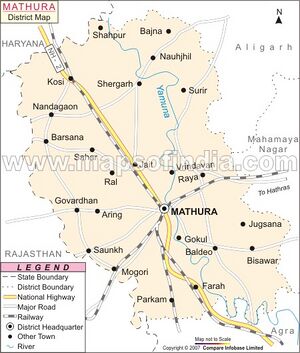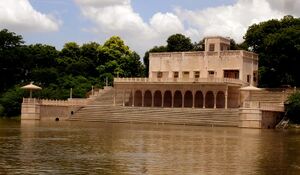Mahaban
| Author:Laxman Burdak, IFS (R) |


Mahaban (महाबन) (Mahavan) is a tahsil in Mathura district in Uttar Pradesh. Kulchand is the ancient name of the present Mahaban.[1] Mahavana (महावन) is mentioned by Panini in Ashtadhyayi and in Mahavansha.
Variants of name
- Kulchand
- Mahavana (महावन)
- Sunigram - At Mahavana (Sunigram) the king Sarvada was reputed to have sold himself and given away the price he fetched to the beggars when he had disposed of everything he had by way of charity.[2]
Jat clans
Villages in Mahaban tahsil
Aangai, Adda Shahpur, Akos Bangar, Alipur, Amirpur, Anandgarhi, Angai, Artauni, Awerni, Baldeo, Balrampur, Banarsi Pur, Bandi, Barauli, Barha Bangar, Bhanda Sujanpur, Bhartiya, Bhudha, Birona, Bureka, Chamarpura, Chaurbamba, Chhbirau, Chholi, Dabdua, Dagheta, Daulatpur, Fatehpura, Gandhi Pur, Garhi Aasha, Garhi Akbar, Garhi Badam, Garhi Goverdhan, Garhi Govind, Garhi Hayatpur, Garhi Khema, Garhi Khobi, Garhi Khuni, Garhi Maharam, Garhi Mangli, Garhi Nahachala, Garhi Nahar, Garhi Nandu, Garhi Ramwal, Garhi Shiram, Garhi Shisha, Garhi Sukha, Garhsauli, Ghera, Gokul, Gotha, Habibpur Bangar, Habibpur, Hasanpur, Hataura, Hatkoli, Hayatpur, Ibrahimpur, Islampur, Jadaupur, Jagdishpur, Jakariapur, Jasa (Gudera), Jatora , Jharautha, Jogipur, Jugsana, Kachnau, Kanjaulighat Bangar, Kanora Bangar, Karnau, Khan Pur, Khapparpur, Kharera, Kheria, Khutli, Kilauni, Kishanpur, Lahrauli Bangar, Madaur, Madaura, Magna, Mahavan Bangar, Manoharpur, Medua, Mohan Pur, Mohpai Bangar, Mubarikpur, Mujahidpur, Murshida Bad Bangar, Muzffarpur, Nabipur, Nagla Adda, Nagla Akos Bangar, Nagla Akos Khadar, Nagla Akos, Nagla Aliya, Nagla Ambu, Nagla Arjun, Nagla Augan, Nagla Azam Bangar, Nagla Babul, Nagla Badana, Nagla Bag, Nagla Bala, Nagla Bali, Nagla Ballu, Nagla Bash, Nagla Bhadur, Nagla Bhalla, Nagla Bhambhoo, Nagla Bich, Nagla Bidhi, Nagla Bihari, Nagla Brahma, Nagla Burj, Nagla Chamar, Nagla Deo Kishan , Nagla Deodia, Nagla Deokaran, Nagla Dom, Nagla Garhaya, Nagla Girdhar, Nagla Govinda, Nagla Gukhrauli, Nagla Hariya, Nagla Hathora, Nagla Heera, Nagla Heta, Nagla Jamuna, Nagla Jamuni, Nagla Jorawal, Nagla Kachnau, Nagla Kallu, Nagla Kamora, Nagla Kankar, Nagla Kathela, Nagla Kharga, Nagla Khema, Nagla Khodua, Nagla Khubi, Nagla Khutia, Nagla Kunji, Nagla Lalgarhi, Nagla Lekha, Nagla Lohra, Nagla Loka, Nagla Maharaj, Nagla Mansha, Nagla Mathra, Nagla Mirbulaki, Nagla Mohan, Nagla Mulchand, Nagla Nanda, Nagla Nobola, Nagla Painth, Nagla Papri, Nagla Patharpati, Nagla Patiram, Nagla Phoolpur, Nagla Polua, Nagla Putha, Nagla Qazi, Nagla Radha, Nagla Radoi Burj, Nagla Ramroop, Nagla Ratiya, Nagla Ratti, Nagla Ray Sing , Nagla Roopram, Nagla Sahtu , Nagla Samaliya, Nagla Sanja, Nagla Sehat, Nagla Seva, Nagla Shisham, Nagla Shora, Nagla Srinagar, Nagla Taj, Nagla Tika, Nagla Uday Singh, Narhauli , Narhauli Junnardar, Nera Bangar, Nera, Noorpur, Pachawar, Paki Gari, Patlauni, Pola Nagla, Prem Nagar, Radoi, Ram Nagariya, Raman Raiti, Rawal , Rawal Bangar, Rithali, Saidpur, Salemabad , Sarai Ali Khan, Sarai Daud, Sarai Salbahan, Sarkand Khera, Sehat , Sehat Khurd , Selkhera, Shahaupur Bangar, Shahjad Pur, Sukhdev Burj, Tatrauta Bangar, Tatrotha, Tula Burj,
Mention by Panini
Mahavana (महावन) is place name mentioned by Panini in Ashtadhyayi. [3]
In Mahavansha
Mahavansa/Chapter 4 tells....When Ajatasattu's son Udayabhaddaka had slain him he, the traitor, reigned sixteen years. Udayabhaddaka's son Anuruddhaka slew (his father) and Anuruddha's son named Muia did likewise. ....When this came to the ears of the thera Yasa, the son of the brahman Kakandaka, who was wandering about in the Vajji country, he betook himself to the Mahavana (vihära) with the resolve to settle the matter.
Mahavansa/Chapter 29 tells that ....When the wherewithal to build was thus brought together he began the work of the Great Thupa on the full-moon day of the month Vesakha, when the Visakha-constellation had appeared.....When the king, glad at heart, had thus had preparation made upon the spot where the Great Thüpa was to be built, he arranged, on the fourteenth day of the bright half of the month Asalha, an assembly of the brotherhood of the bhikkhus.....
Mahavansa/Chapter 29 tells.... From various (foreign) countries also did many bhikkhus come hither; what need to speak of the coming of the brotherhood living here upon the island (Lanka).....From the Mahavana (monastery) in Vesali came the thera Urubuddharakkhita.
जाटों से संबंधित(इतिहास)
महावन पर जदुवंशी हागा गोत्री जाटों ने राज किया है, महावन में इनका दुर्ग है(जो वर्तमान में एक खंडर की श्रेणी में आता है क्योंकि महमूद गजनवी द्वारा इस किले को नष्ट कर दिया गया था।
महमूद गजनवी के नवे आक्रमण के दौरान सन्1017ईस्वी में महावन पर हागा गोत् के जाट शासक चौधरी कुलचंद हँगा का शासन था।[4]
History
Sir H. M. Elliot writes[5] (Edited by John Dowson), quoting the Yamini which says that, in his Twelfth Expedition A.H. 409 (1018-1019 AD) after passing by the borders of Kashmir, that is, close under the sub-Himalayan range, and crossing the Jumna, Mahmud of Ghazni takes Baran, which is the ancient name of the present Bulandshahr for which more modern authors, not knowing what " Baran" was, substitute "Mirat" — then Kulchand's fort, which is the Mahaban of the other — then crossing the Jumna he takes Mathura — and then recrossing the Jumna, he proceeds to Kanauj, and takes that and its seven detached forts, of which the ruins of some may still be traced. He then goes to Munj, " a city of Brahmans."
Mahaban prasasti of V.1207 (1150 A.D.)
The ruler of Bhadanaka-desa against whom Vigraharaja IV of Sakambhari had to fight probably was either Kumarapala I who was instructed by the Kharatara Acharya Jinadatta Suri (1112-1154 AD) or Kumarapala’s successor Maharajadhiraja Ajayapala who was ruling near Mathura in V. 1207 (1150 A.D.) (See Mahaban prasasti of V.1207, EI,I,pp.289ff and II, 276ff) He was succeeded by Haripala whose rule is vouched for by tradition as well as an inscription of V. 1227 (1170 AD) (See EI, II, p. 275) As to Prithviraja III’s Bhadanaka rival, he should probably be Haripala's successor, Sahanapala, for whom we have an image inscription from Aghatapura in the old Bharatpur State. In 1196 A.D., when Tribhuvanagiri was captured by Muhammad Ghori, the ruler on the throne of Bayana was Kumarapala, and he has to be called Kumarapala II, as we know of another Kumarapala of this line as Jinadatta Suri's contemporary. Further history of this line can be had from the Vrittavilasa of the poet Jadunatha who was patronised by Gopal Singh of Karauli, a direct descendant of Kumarapala II.
महावन
विजयेन्द्र कुमार माथुर[6] ने लिखा है ...1.महावन (AS, p.725) = जिला मथुरा उत्तर प्रदेश के समीप यमुना के दूसरे तट पर अति प्राचीन स्थान है जिसे बालकृष्ण की क्रीड़ास्थली माना जाता है. यहां अनेक छोटे-छोटे मंदिर हैं जो अधिक पुराने नहीं हैं. ब्रिज के 84 वनों में महावन मुख्य था. महावन को औरंगजेब (1618–1707) के समय में उसकी धर्मांध नीति का शिकार बनना पड़ा था. इसके बाद 1757 ईस्वी में अफगान अहमदशाह अब्दाली [p.726] ने जब मथुरा पर आक्रमण किया तो उसने महावन में सेना का शिविर बनाया. वह यहाँ ठहर कर गोकुल को नष्ट करना चाहता था किंतु महावन के 4000 नागा सन्यासियों ने उसकी सेना के 2000 सिपाहियों को मार डाला और स्वयं भी वीरगति को प्राप्त हुए. गोकुल पर होने वाले आक्रमण का इस प्रकार निराकरण हुआ और अब्दाली ने अपनी फ़ौज वापस बुला ली. इसके पश्चात महावन के शिविर में विशूचिका बीमारी के प्रकोप से अब्दाली के अनेक सिपाही मर गए. वह शीघ्र ही दिल्ली लौट गया. किन्तु जाते-जाते मथुरा वृंदावन आदि स्थानों पर लूट मचाई.
2.महावन (AS, p.726) = महावंश 4, 12 में वर्णित एक स्थान भी महावन था जो संभवत:वैशाली के प्रमोदवन का नाम था. इसका अभियान वसाढ़ (जिला मुजफ्फरपुर, बिहार) से 2 मील उत्तर पश्चिम की ओर वर्तमान कोलुआ से से किया गया है जहां अशोक का एक स्तंभ भी विद्यमान है. बसाढ़ ग्राम प्राचीन वैशाली नगरी के स्थान पर बसा हुआ है. [7]
जाट इतिहास
दलीपसिंह अहलावत लिखते हैं - सम्राट् शाहजहाँ ने 1654 ई० के बाद अपने पुत्र दारा शिकोह को आगरा सूबे का प्रबन्ध और मथुरा का परगना जागीर में दे दिया। दाराशिकोह स्वयं नम्र स्वभाव का था और हिन्दू धर्म के प्रति सहानुभूति रखता था। फलतः ब्रजमण्डल में सहिष्णुतापूर्ण उदार धार्मिक नीति को प्रश्रय मिला। सम्राट् ने वजीर सादुल्ला खां को गोकुल की खालसा (सरकार के अधिकृत) भूमि जागीर में दे दी। वजीर ने जाटप्रधान ग्रामों के बीच में सादाबाद नामक नवीन छावनी स्थापित की। उसने सन् 1652 ई० में ठेनुआ गोत्री प्रधान टप्पा, जावरा, जलेसर के कुछ भाग, खंदौली के सात गांव और महावन के 80 गांवों पर कब्जा करके सादाबाद के परगने में शामिल कर लिए। यह वजीर सादाबाद में 1652 से 7 अप्रैल, 1656 ई० तक रहा।[8]
In Mahabharata
Notable persons
References
- ↑ Sir H. M. Elliot Edited by John Dowson: The history of India : as told by its own historians. Volume II/Note D. — Mahmud's Expeditions to India,p.458
- ↑ Buddha Prakash: Evolution of Heroic Tradition in Ancient Panjab, X. The Struggle with the Yavanas, Sakas and Kushanas, p.102
- ↑ V. S. Agrawala: India as Known to Panini, 1953, p.143
- ↑ लेखक कंवरपाल सिंह; पुस्तक पाण्डव गाथा, पृष्ठ 207
- ↑ The history of India : as told by its own historians. Volume II/Note D. — Mahmud's Expeditions to India,p.458
- ↑ Aitihasik Sthanavali by Vijayendra Kumar Mathur, p.725-726
- ↑ Aitihasik Sthanavali by Vijayendra Kumar Mathur, p.726
- ↑ Jat History Dalip Singh Ahlawat/Chapter VIII (Page 623)
Back to Jat Villages/Inscriptions/Jat Forts
- Jat Villages
- Jat Villages in Uttar Pradesh
- Uttar Pradesh Tahsils
- Villages in Mathura
- No Gotras
- Inscriptions
- Inscriptions in Uttar Pradesh
- Inscriptions in Mathura
- Jat Forts
- Jat Forts in Uttar Pradesh
- Jat Forts in Mathura
- Mahabharata People
- Mahabharata Places
- Mahabharata People and Places
- People and Places by Panini
- Buddhism
- AS
- AS UP

